The Cloud Database and DBaaS Market is estimated to be valued at USD 20.2 billion in 2025 and is projected to reach USD 30.1 billion by 2035, registering a compound annual growth rate (CAGR) of 4.1% over the forecast period.
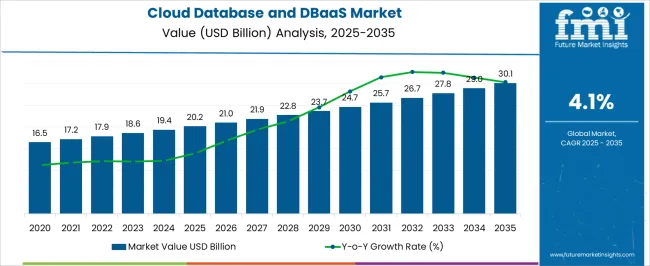
| Metric | Value |
|---|---|
| Cloud Database and DBaaS Market Estimated Value in (2025 E) | USD 20.2 billion |
| Cloud Database and DBaaS Market Forecast Value in (2035 F) | USD 30.1 billion |
| Forecast CAGR (2025 to 2035) | 4.1% |
The cloud database and DBaaS market is experiencing robust expansion driven by the growing digitalization of enterprises, increasing data volumes, and the rising need for scalable and cost effective database solutions. Organizations are rapidly shifting from on premise infrastructures to cloud based models to enhance agility, reduce maintenance costs, and support real time data processing.
Cloud platforms are enabling seamless integration with analytics, AI, and machine learning applications, further elevating demand. Data security enhancements, compliance frameworks, and continuous innovation in encryption and backup technologies are strengthening trust in cloud solutions across regulated industries.
With enterprises focusing on operational efficiency, business continuity, and global accessibility, the market outlook remains strong. Opportunities lie in hybrid deployments, AI powered database optimization, and industry specific DBaaS models tailored to evolving enterprise needs.
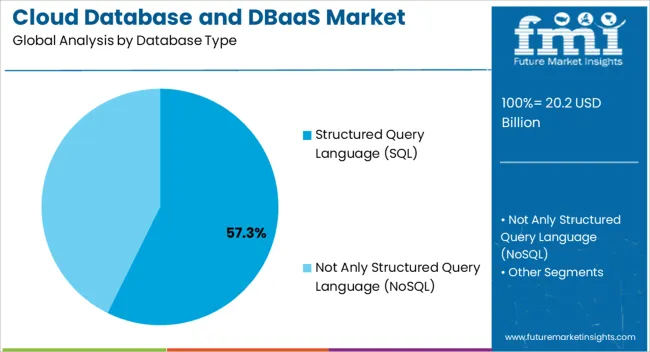
The structured query language segment is projected to account for 57.30% of market revenue by 2025, positioning it as the most dominant database type. This leadership is supported by its wide adoption in mission critical enterprise applications, robust transaction management, and ability to ensure data integrity across large systems.
Its compatibility with existing IT infrastructure and familiarity among developers and administrators have further reinforced its dominance.
With organizations prioritizing reliability, structured storage, and strong consistency in data management, SQL based databases continue to remain the foundation of enterprise level operations.
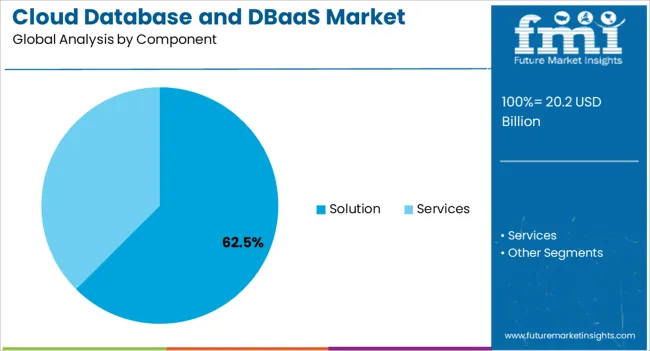
The solution segment is expected to hold 62.50% of total revenue by 2025 within the component category, making it the leading contributor. The segment’s strength is attributed to its ability to provide enterprises with scalable platforms, enhanced data storage capabilities, and integrated features such as backup, recovery, and data replication.
Continuous innovation from major cloud providers in offering advanced automation, optimization, and seamless migration support has accelerated solution adoption.
Enterprises increasingly view cloud database solutions as essential for supporting digital transformation initiatives, thereby solidifying their dominance in the market.
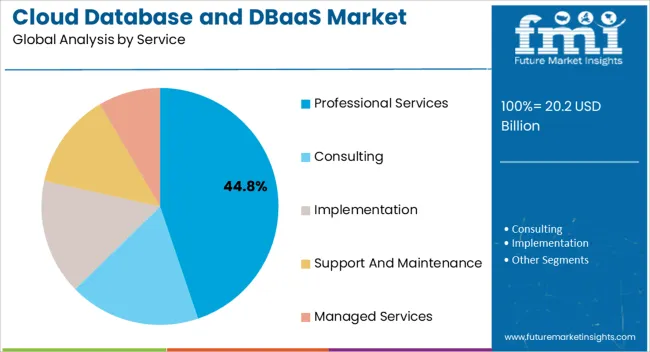
The professional services segment is anticipated to represent 44.80% of overall revenue by 2025 in the services category. This position is driven by the rising need for consulting, customization, integration, and maintenance support in complex enterprise environments.
Large scale migration projects, hybrid deployment strategies, and regulatory compliance requirements have all intensified demand for professional expertise. Service providers are enabling enterprises to optimize cloud database performance, ensure secure configurations, and streamline workloads.
As companies continue to scale their cloud adoption, the professional services segment remains integral in ensuring smooth transitions and operational efficiency.
Businesses are seeing an insane amount of demand for cloud databases and DBaaS due to heavy rise in data storage after the pandemic. Increasing number of people started visiting different online channels such as gaming sites, music among others. Hence, the market is likely to grow significantly.
In order to comprehend and handle the insights evaluated from massive datasets, the demand of cloud databases and DBaaS among businesses is increasing. These businesses are analyzing this data to earn competitive edge in the market. Cloud database and DBaaS fulfills the demand these businesses are looking for, increasing the demand of these solutions.
The demand for cloud databases and DBaaS is also growing as moving to the cloud reduces the cost of maintaining a sprawling, continually increasing database architecture.
Physical infrastructure expenditures become obsolete, and non-peak consumption hours can be scaled down effortlessly and economically. Due to these factors, the sales of cloud database and DBaaS is anticipated to rise, contributing to the overall growth of the cloud database and DBaaS market.
Cloud database providers' built-in security capabilities improve enterprise network security, which is a key factor propelling the demand for cloud database and DBaaS solutions during the forecast period. Default data encryption, integrated identity, access management controls, and regulatory compliance tools are a few other factors responsible for growing sales of cloud databases and DBaaS solutions.
The key advantage of moving to a cloud-based database architecture from a largely on-premises database solution for many enterprises is accessibility. This is anticipated to boost the global market for cloud databases and DBaaS as the global corporate sector rises from the pandemic of 2024 with a renewed focus on remote work arrangements.
Cloud databases and DBaaS can be scaled up or down based on actual usage, as opposed to purchasing physical database capacity in anticipation of future needs that may or may not arise.
The demand for cloud databases and DBaaS is increasing since these solutions are simple to set up and less expensive, allowing businesses to develop business continuity plans that can be implemented automatically in the case of a network failure.
The sales of cloud databases and DBaaS solutions are built with disaster recovery in mind. Data is replicated between servers, allowing businesses to access information instantly, decreasing downtime and productivity. These factors combined aid in the development of cloud databases and DBaaS market share.
The demand for cloud databases and DBaaS is rising as encrypted cloud databases are significant for distributed workforces, such as remote workers and worldwide enterprises with multiple locations. As a result, the sales of cloud databases and DBaaS solutions are likely to rise.
Public cloud segment hold 43.4% market share in the year 2025. Big Data as a Service (BDaaS) can be set up using a public cloud, private cloud, or hybrid cloud. A public cloud works like regular cloud computing, where a service provider offers resources like virtual machines (VMs), applications, and storage over the Internet. These services can be free or on a pay-per-use basis.
The structured query language segment is anticipated to have a commanding share of 55.5% in the cloud databases and the DBaaS market.
For a long time, relational databases have dominated multiple verticals, providing varied mechanisms for data storage, concurrency control, and transaction.
It has also provided standard interfaces for data and reporting integration. Structured Query Language is a relational database's application program interface (API) and standard user. The SQL database allows you to access managed relational databases on demand.
In the cloud database and Database-as-a-Service (DBaaS) market, solutions are offered as components that enable organizations to build and customize their database environments. These solutions provide specific functionalities and capabilities to enhance database management and operations.
The United Kingdom cloud database and DBaaS industry are helping to stabilize and see vital prospects thanks to important government regulations and funding to support research and development projects in the ICT industry.
Leading companies are investing hugely to incorporate AI into their products across a range of industries. These industries are telecommunications, consumer electronics, and automobiles, which are significant elements affecting sector sales.
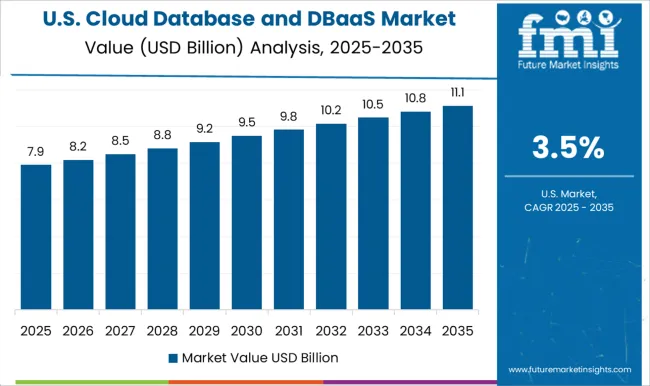
The United States and Canada are likely to influence North America’s cloud databases and the DBaaS market with a CAGR of 13.8%. The region's businesses are the most forward-thinking in terms of AI, machine learning, and cloud adoption, propelling the cloud databases and DBaaS market's growth.
China is also anticipated to show promising growth potential in the cloud databases and DBaaS market. During the forecast period, China's cloud databases and DBaaS market is anticipated to expand steadily with a CAGR of 13.4%. Technological advancements and smooth government regulations in the region are likely to be the driving factors in the cloud databases and DBaaS market.
In India, the potential of cloud database and DBaaS is quite high as the market is growing rapidly at 15.4% CAGR. The country is developing rapidly in the market due to its growing IT industry, healthier business environment and increase in digitization. These factors have empowered the adoption of cloud-based database solutions.
The cloud database and database-as-a-service market is fragmented due to the presence of numerous solutions providers including global and regional companies. Hence, the companies in are working to grow their global footprint by making strategic partnerships, collaborations and product launches.
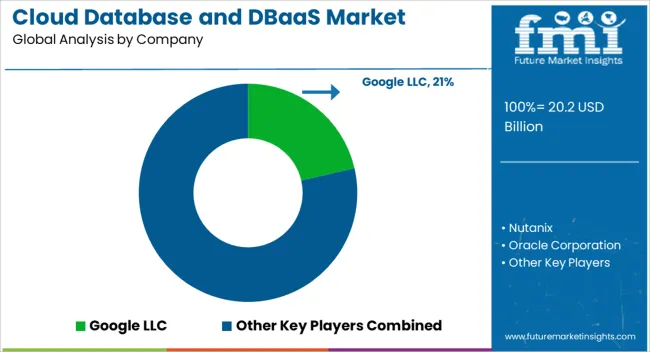
| Attribute | Details |
|---|---|
| Growth Rate | CAGR of 14.1% from 2025 to 2035 |
| Base Year of Estimation | 2025 |
| Historical Data | 2020 to 2025 |
| Forecast Period | 2025 to 2035 |
| Quantitative Units | Revenue in USD million and Volume in Units and F-CAGR from 2025 to 2035 |
| Report Coverage | Revenue Forecast, Volume Forecast, Company Ranking, Competitive Landscape, growth factors, Trends, and Pricing Analysis |
| Key Segments Covered | Database Type, Component, Service, Vertical, Organization Size, By Region |
| Regions Covered | North America; Latin America; Europe; East Asia; South Asia; The Middle East & Africa; Oceania |
| Key Countries Profiled | The United States, Canada, Brazil, Mexico, Germany, Italy, France, The United Kingdom, Spain, Russia, China, Japan, India, GCC Countries, Australia |
| Key Companies Profiled | Google LLC; Nutanix; Oracle Corporation; IBM Corporation; SAP SE; Amazon Web Services, Inc.; Alibaba Cloud; MongoDB, Inc.; Microsoft Corp.; Teradata; Ninox Software GmbH; DataStax |
| Customization & Pricing | Available upon Request |
The global cloud database and DBaaS market is estimated to be valued at USD 20.2 billion in 2025.
The market size for the cloud database and DBaaS market is projected to reach USD 30.1 billion by 2035.
The cloud database and DBaaS market is expected to grow at a 4.1% CAGR between 2025 and 2035.
The key product types in cloud database and DBaaS market are structured query language (sql) and not anly structured query language (nosql).
In terms of component, solution segment to command 62.5% share in the cloud database and DBaaS market in 2025.






Our Research Products

The "Full Research Suite" delivers actionable market intel, deep dives on markets or technologies, so clients act faster, cut risk, and unlock growth.

The Leaderboard benchmarks and ranks top vendors, classifying them as Established Leaders, Leading Challengers, or Disruptors & Challengers.

Locates where complements amplify value and substitutes erode it, forecasting net impact by horizon

We deliver granular, decision-grade intel: market sizing, 5-year forecasts, pricing, adoption, usage, revenue, and operational KPIs—plus competitor tracking, regulation, and value chains—across 60 countries broadly.

Spot the shifts before they hit your P&L. We track inflection points, adoption curves, pricing moves, and ecosystem plays to show where demand is heading, why it is changing, and what to do next across high-growth markets and disruptive tech

Real-time reads of user behavior. We track shifting priorities, perceptions of today’s and next-gen services, and provider experience, then pace how fast tech moves from trial to adoption, blending buyer, consumer, and channel inputs with social signals (#WhySwitch, #UX).

Partner with our analyst team to build a custom report designed around your business priorities. From analysing market trends to assessing competitors or crafting bespoke datasets, we tailor insights to your needs.
Supplier Intelligence
Discovery & Profiling
Capacity & Footprint
Performance & Risk
Compliance & Governance
Commercial Readiness
Who Supplies Whom
Scorecards & Shortlists
Playbooks & Docs
Category Intelligence
Definition & Scope
Demand & Use Cases
Cost Drivers
Market Structure
Supply Chain Map
Trade & Policy
Operating Norms
Deliverables
Buyer Intelligence
Account Basics
Spend & Scope
Procurement Model
Vendor Requirements
Terms & Policies
Entry Strategy
Pain Points & Triggers
Outputs
Pricing Analysis
Benchmarks
Trends
Should-Cost
Indexation
Landed Cost
Commercial Terms
Deliverables
Brand Analysis
Positioning & Value Prop
Share & Presence
Customer Evidence
Go-to-Market
Digital & Reputation
Compliance & Trust
KPIs & Gaps
Outputs
Full Research Suite comprises of:
Market outlook & trends analysis
Interviews & case studies
Strategic recommendations
Vendor profiles & capabilities analysis
5-year forecasts
8 regions and 60+ country-level data splits
Market segment data splits
12 months of continuous data updates
DELIVERED AS:
PDF EXCEL ONLINE
Cloud Data Encryption Solutions Market Size and Share Forecast Outlook 2025 to 2035
Cloud Service Market Size and Share Forecast Outlook 2025 to 2035
Cloud Analytics Market Size and Share Forecast Outlook 2025 to 2035
Cloud ERP Industry Analysis in Latin America Forecast Outlook 2025 to 2035
Cloud Backup Service Industry Analysis in Latin America Size and Share Forecast Outlook 2025 to 2035
Cloud Compliance Market Size and Share Forecast Outlook 2025 to 2035
Cloud-Based ITSM Market Size and Share Forecast Outlook 2025 to 2035
Cloud IT Infrastructure Hardware Market Size and Share Forecast Outlook 2025 to 2035
Cloud POS Market Size and Share Forecast Outlook 2025 to 2035
Cloud Systems Management Software Market Size and Share Forecast Outlook 2025 to 2035
Cloud Telephony Services Market Size and Share Forecast Outlook 2025 to 2035
Cloud Field Service Management (FSM) Market Size and Share Forecast Outlook 2025 to 2035
Cloud Seeding System Market Size and Share Forecast Outlook 2025 to 2035
Cloud Professional Services Market Size and Share Forecast Outlook 2025 to 2035
Cloud Based Collaboration Software Market Size and Share Forecast Outlook 2025 to 2035
Cloud Printing Services Market Size and Share Forecast Outlook 2025 to 2035
Cloud Migration Service Market Size and Share Forecast Outlook 2025 to 2035
Cloudifier Market Size and Share Forecast Outlook 2025 to 2035
Cloud ERP Market Size and Share Forecast Outlook 2025 to 2035
Cloud Computing Market Size and Share Forecast Outlook 2025 to 2035

Thank you!
You will receive an email from our Business Development Manager. Please be sure to check your SPAM/JUNK folder too.
Chat With
MaRIA